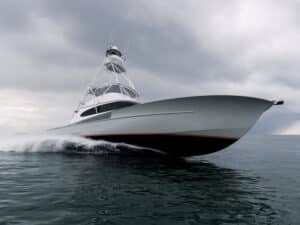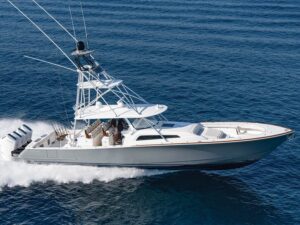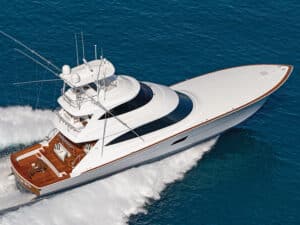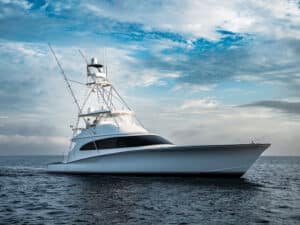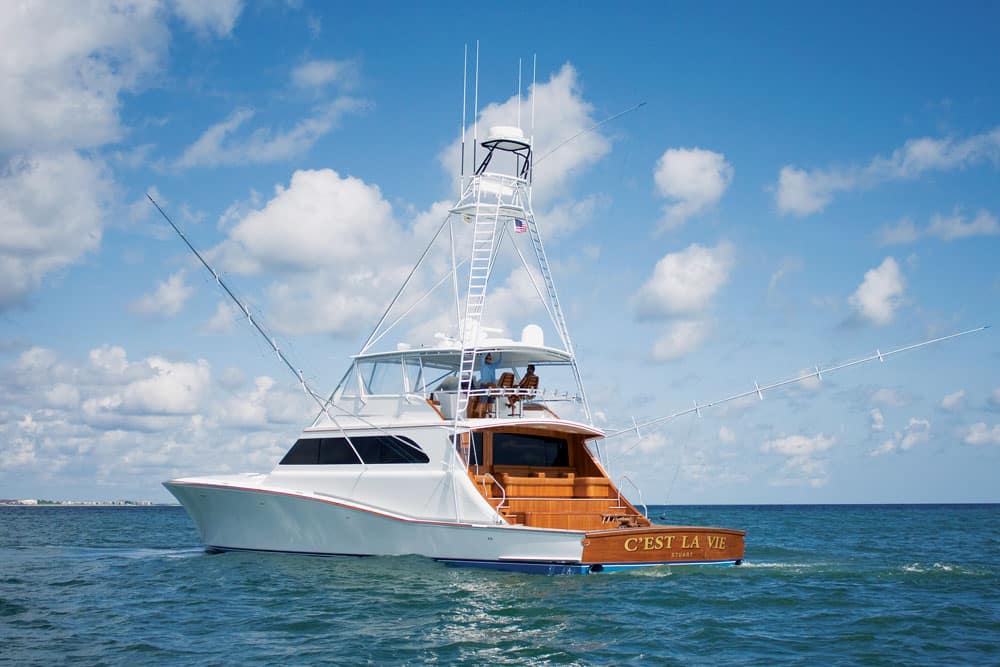
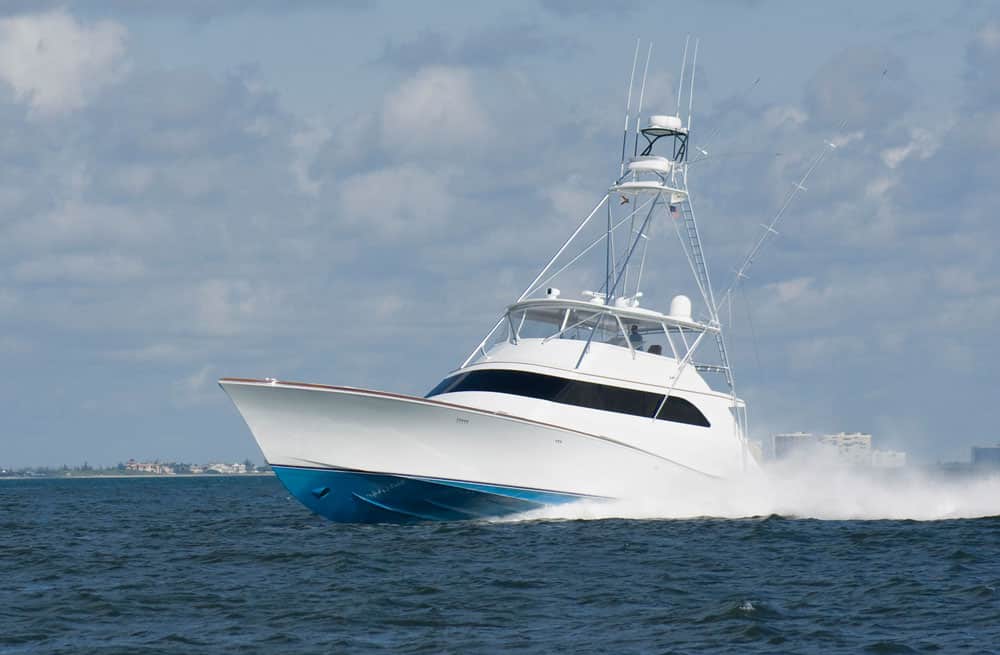
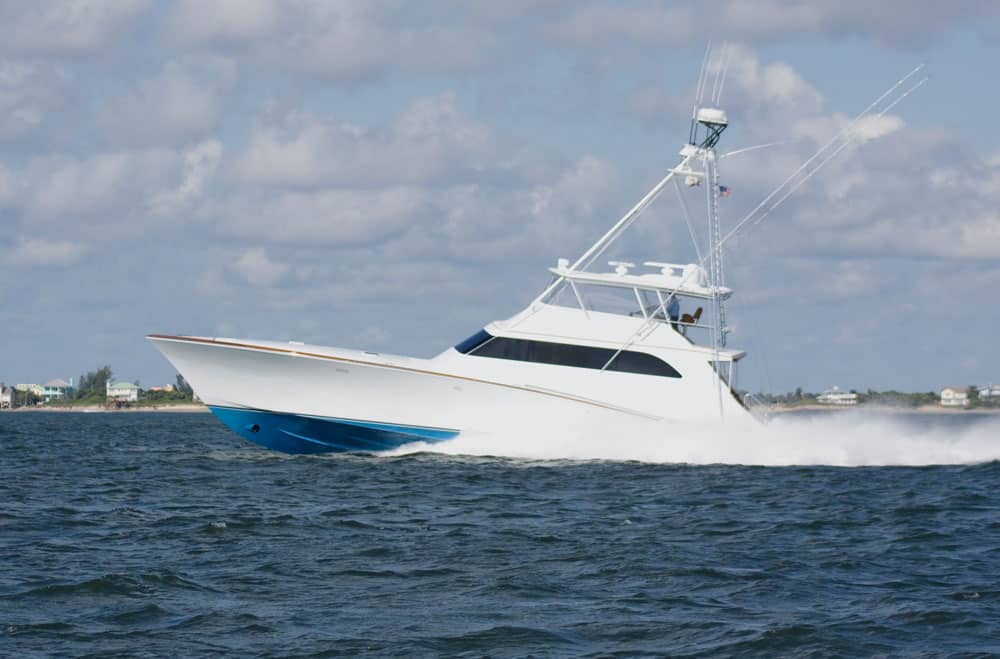
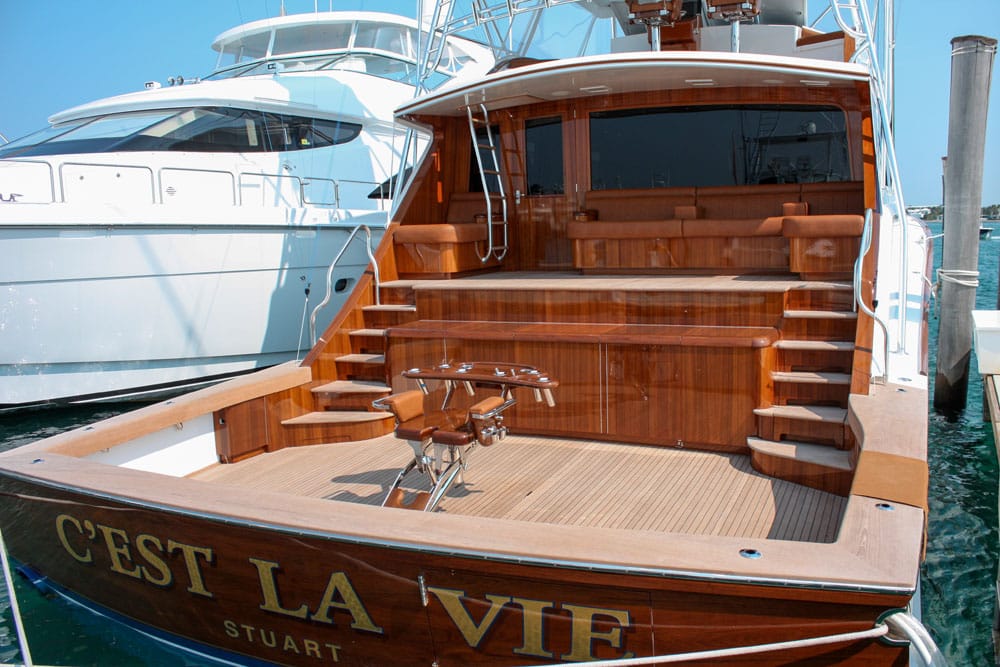
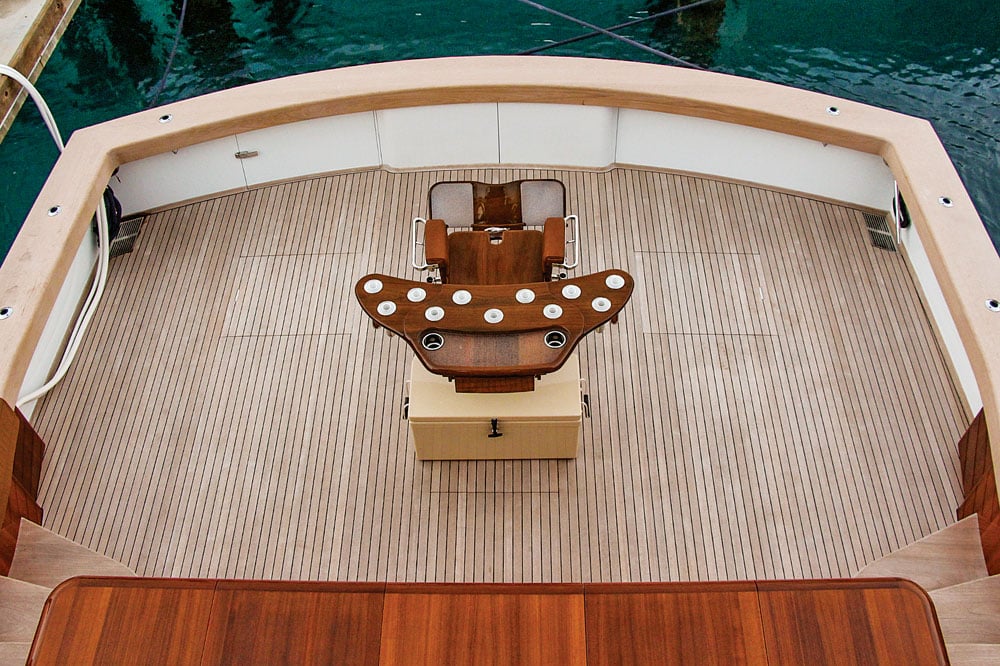
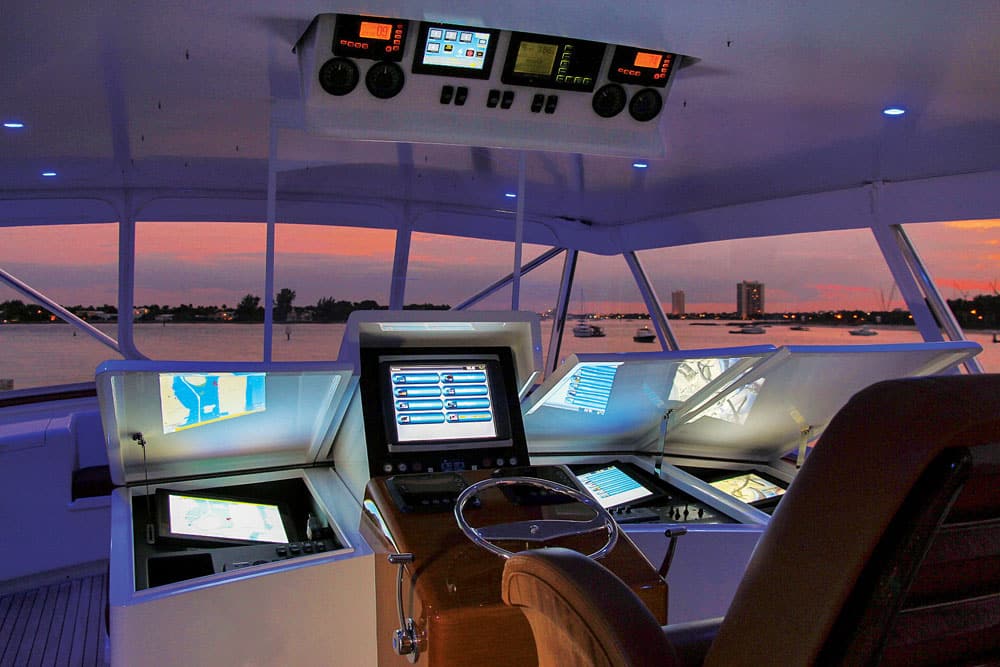
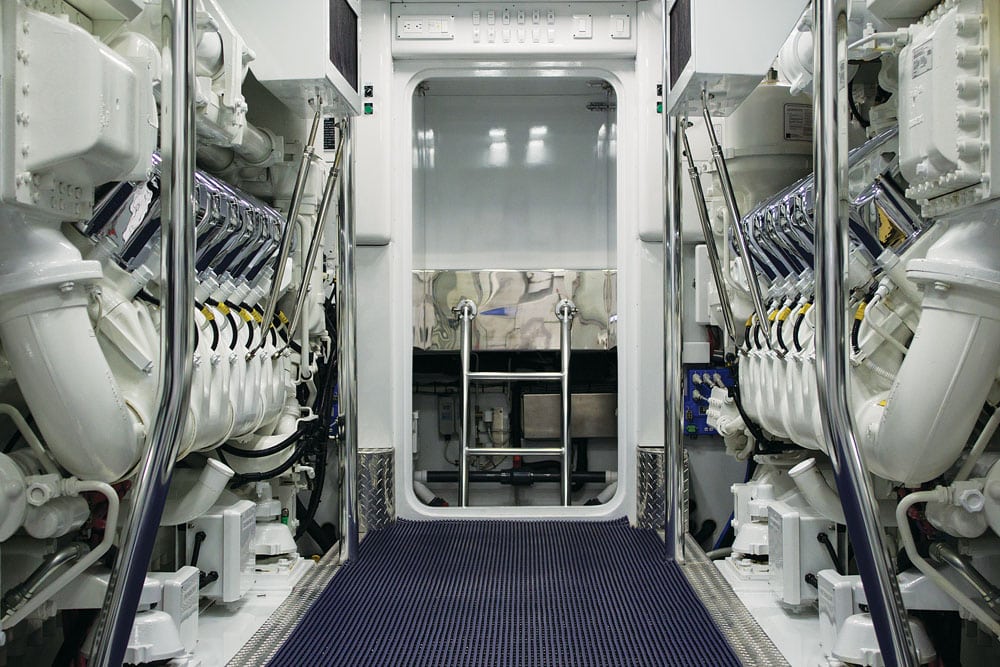
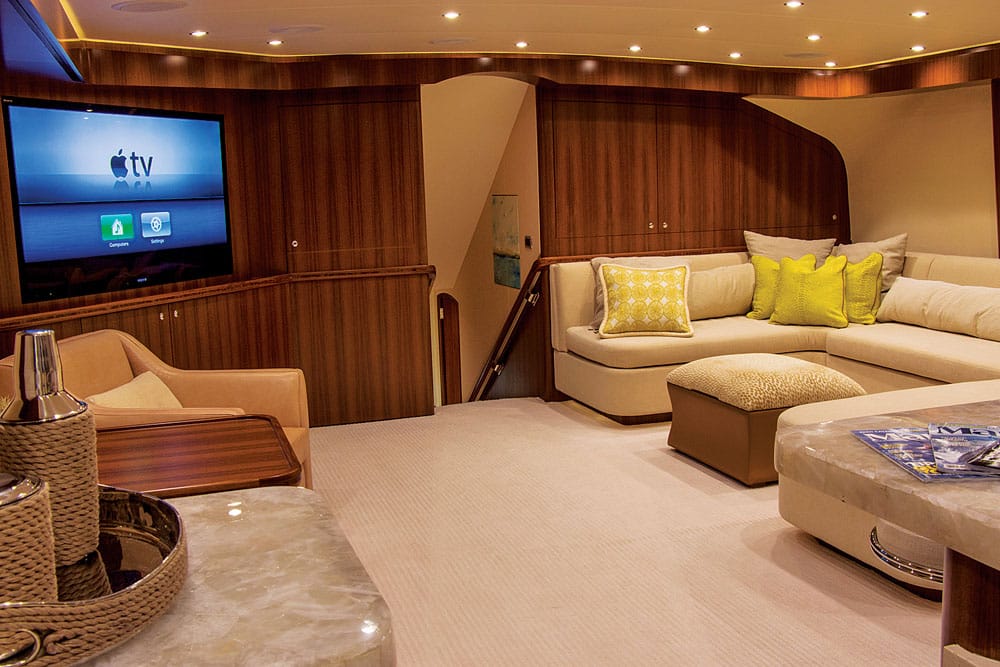
As we pulled in the last of the lines that tethered us to our slip at the south dock of Palm Beach’s Sailfish Marina, someone watching from the quay as C’est La Vie‘s captain began sliding the big boat out into the channel and free of the land smiled and said, “Have a nice flight.” Within minutes of clearing the inlet, and with the calm open ocean before us, it was quite evident what that remark meant.
Performance
The bow of the 90-foot C’est La Vie, the latest build from Dominick Lacombe’s Stuart, Florida-based American Custom Yachts (ACY), rose a bit at first, and then I heard the turbochargers kick in. The big boat lifted herself out of the water as the engines spooled up past 1,100 rpm, past 1,500, and then settled in at 1,750. And just like that, displacing some 190,000 pounds, she was flirting with 39 knots and flying across the relatively calm water off Palm Beach Inlet. At 1,950 rpm, we hit just under 42 knots, and the boat finally topped out at 44.6 knots while turning 2,100 rpm.
“For me, it all started when I was a kid fishing the offshore canyons back in Cape May, New Jersey,” Lacombe says. “In those days, if you had an 18-knot boat and you were running 70 to 80 miles offshore, well, that was pretty good. I knew back then that big, fast boats were the kind I wanted to be involved with. The faster you got to the fishing grounds, the more time you could spend there.” The 90-footer seemed to echo Lacombe’s principles as the captain put the big boat through a series of exhilarating turns and maneuvers, one of which involved backing down hard and watching the ensuing water drain remarkably fast out of the huge cockpit.
Never wavering from his fast-boat philosophy, by the time he was 29, Lacombe was running the Monterey boat company. In June of 1992, with the initial launch of a 58, ACY was born. The company then built a 63- and a 65-footer; all of the boats were named Freedom.
Lacombe told me of a previous build, whose over-the-top galley was its central focus, but C’est La Vie‘s owner, and also the owner of ACY, had a much different focus. This boat would be built around a pair of massive MTU 16V 4000 M93L 9,200 hp engines.
Construction
Constructing C’est La Vie, with her noticeably low profile for such a big vessel, required a fine and exacting blend of technology, vision and boatbuilding savvy. Having a boat of this size that can deliver the kind of performance expected from a sport-fishing machine is something else; and that is what Lacombe and his crew are dedicated to achieving.
“There is a period of time from when you start talking to a customer until the contract is signed,” Lacombe says. “Our owners are seasoned veterans of the build process, and when they finally decide on ACY, we’ve already gotten to know them very well, and know just how they are planning to use their boat. We don’t try and tell them what they want; instead, we explain what we’ve done in the past and what will fit their needs, and then we discuss what they are looking for.”
C’est La Vie is a cold-molded jig boat built with five layers of 12 mm Okoume plywood on the bottom, with Kevlar and fiberglass inside and out. From the waterline up, it’s two layers of the ply, again with Kevlar and fiberglass inside and out. To help save weight, ACY uses Divinycell composite coring in the decks and Nida-Core in the deck hatches. For the cabinetry and any nonstructural bulkheads, they use Tri-Cell. For the structural bulkhead, ACY uses vacuum-bagged marine-grade plywood over balsa core.
Engine Room
Nothing has been spared to make sure she is rock-solid all around. Being able to handle the incredible weight and power of the main engines, each clocking in at 10-plus tons and being able to develop the kind of torque to make your knees weak meant that Lacombe and his crew needed to plan and build a special engine bed to handle the load.
“The motor mount system is all aluminum,” Lacombe said as he and I stood in the cavernous engine room before all that power came to life. “And the entire space here, from chine to chine and bulkhead to bulkhead, is integrated with an aluminum engine bed system, allowing the motors to not only sit on the keel, but on every stringer and chine as well.”
In addition, V-drives are used to lessen the shaft angle, resulting in a more efficient use of all the horsepower. “Backing down is also more effective, since we’re not digging in and pulling the boat down.” Lacombe and his ACY crew even had to design and fabricate special air boxes to allow the monstrous power plants to get sufficient ventilation.
Interior
Given her length and beam, and that she’s all custom, the interior of C’est La Vie was designed and outfitted according to the owner’s demands and his planned use of the boat both to be an ultimate fishing platform and to accommodate his large family.
To that end, her main salon offers wide-open spaces, with all galley appliances housed in belowcounter drawers and cabinets. There is nothing to block the spectacular views out of those extra-large windows to either side, or from the salon’s aft end as well.
Given all the room here, the seating arrangements and dining space can be configured in several ways, all of which work within the given dimensions. “All the furniture and cabinetry you see here was done under one roof, the same one that builds the boat,” Lacombe pointed out as we took a turn around the interior. “The fabrics, leathers and any canvas are all done in house by American Canvas & Interiors.”
Below
A centerline staircase leads down to a long hallway and the six-stateroom (three over to port and three on the starboard side), five-head layout. Lacombe and I opened doors, drawers and closets, and I observed more-than-ample storage areas in each room. Indeed, I found so much space aboard C’est La Vie — from cockpit to engine room to flying bridge — that once provisioned, and but for fuel considerations, she is quite able to accommodate her crew for an extended stay away from any dock.
Cockpit
Of course, being a no-nonsense and not-for-the-faint-of-heart fishing machine, C’est La Vie‘s flying bridge and cockpit mean business. Lacombe and his team outfitted these areas with everything one could want in a deepwater, horizon-chasing sport-fisherman. The centerline helm offers plenty of room for a vast array of electronics, communication and navigational equipment, installed by affiliate IMS American Marine Electronics.
Forward seating is abundant, and there is space for any number of cooler and freezer options you may require. And don’t forget those 60-foot Rupp five-spreader riggers on that substantial Bausch-American tower, custom fabricated and installed by ACY.
The teak-soled cockpit offers the fishing crew the kind of space and amenities that one would expect on a world-class tourney boat, and as we banked on a gentle, controlled 40-knot-plus turn and powered our way back to the dock, I could only imagine all those trolled lines aft with cutting fish eyeing everything from the teasers to Spanish mackerels.
If you’re thinking of competing in the rarefied air of a truly custom sport-fishing boat, a visit to ACY’s Stuart, Florida, facility is an absolute must. While the cost of fulfilling your dream is something you will need to discuss with Lacombe and his crew, the effect of having your hands on the wheel of one of his designs is guaranteed to be priceless.
| ### SPECIFICATIONS | ### EQUIPMENT LIST |
| LOA: 90′ | KEP monitors |
| Beam: 22’3″ | Garmin 7215, 6208, 6212, GSD26 CHIRP |
| LWL: 79’3″ | Airmar R599LH 3 kW transducer |
| DEADRISE: 13.5 degrees | Furuno NavNet 3D MFDBBs, KW digital radar |
| WEIGHT: 210,000 pounds | Furuno BBWX2 Sirius Weather |
| Draft: 6’8″ (half load) | Simrad AP50 Autopilot |
| Fuel: 6,185 gallons | KVH V7 V-SAT |
| Water: 453 gallons | Engine room, pump room and underwater cameras |
| Engines: 16V 4000 M93L 2,100 rpm | Savant A/V integration allows iPad control in all locations |
| Full selection of audio and video sources with in-ceiling speakers | |
| Village Marine 1600GPD PW1600M 220V, 1200 GPD PW1200M 220V watermakers |
American Custom Yachts
772-221-9100 americancustomyachts.com
